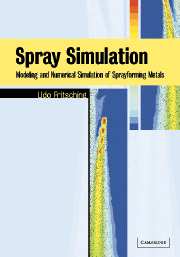4 - Fluid disintegration
Published online by Cambridge University Press: 10 August 2009
Summary
Having divided the atomization and spray process modelling procedure into three main areas:
atomization (disintegration),
spray, and
compaction,
in this chapter we look specifically at the disintegration process as it applies to the case of molten metal atomization for spray forming. We begin by breaking down disintegration into a number of steps:
the melt flow field inside the tundish and the tundish melt nozzle,
the melt flow field in the emerging and excited fluid jet,
the gas flow field in the vicinity of the twin-atomizer,
interaction of gas and melt flow fields, and
resulting primary and secondary disintegration processes of the liquid melt.
Several principal atomization mechanisms and devices exist for disintegration of molten metals. An overview of molten metal atomization techniques and devices is given, for example, in Lawley (1992), Bauckhage (1992), Yule and Dunkley (1994) and Nasr et al. (2002). In the area of metal powder production by atomization of molten metals, or in the area of spray forming of metals, especially, twin-fluid atomization by means of inert gases is used. The main reasons for using this specific atomization technique are:
the possibility of high throughputs and disintegration of high mass flow rates;
a greater amount of heat transfer between gas and particles allows rapid, partial cooling of particles;
direct delivery of kinetic energy to accelerate the particles towards the substrate/deposit for compaction;
minimization of oxidation risks to the atomized materials within the spray process by use of inert gases.
A common characteristic of the various types of twin-fluid atomizers used for molten metal atomization is the gravitational, vertical exit of the melt jet from the tundish via the (often cylindrical) melt nozzle.
- Type
- Chapter
- Information
- Spray SimulationModeling and Numerical Simulation of Sprayforming metals, pp. 26 - 93Publisher: Cambridge University PressPrint publication year: 2004



